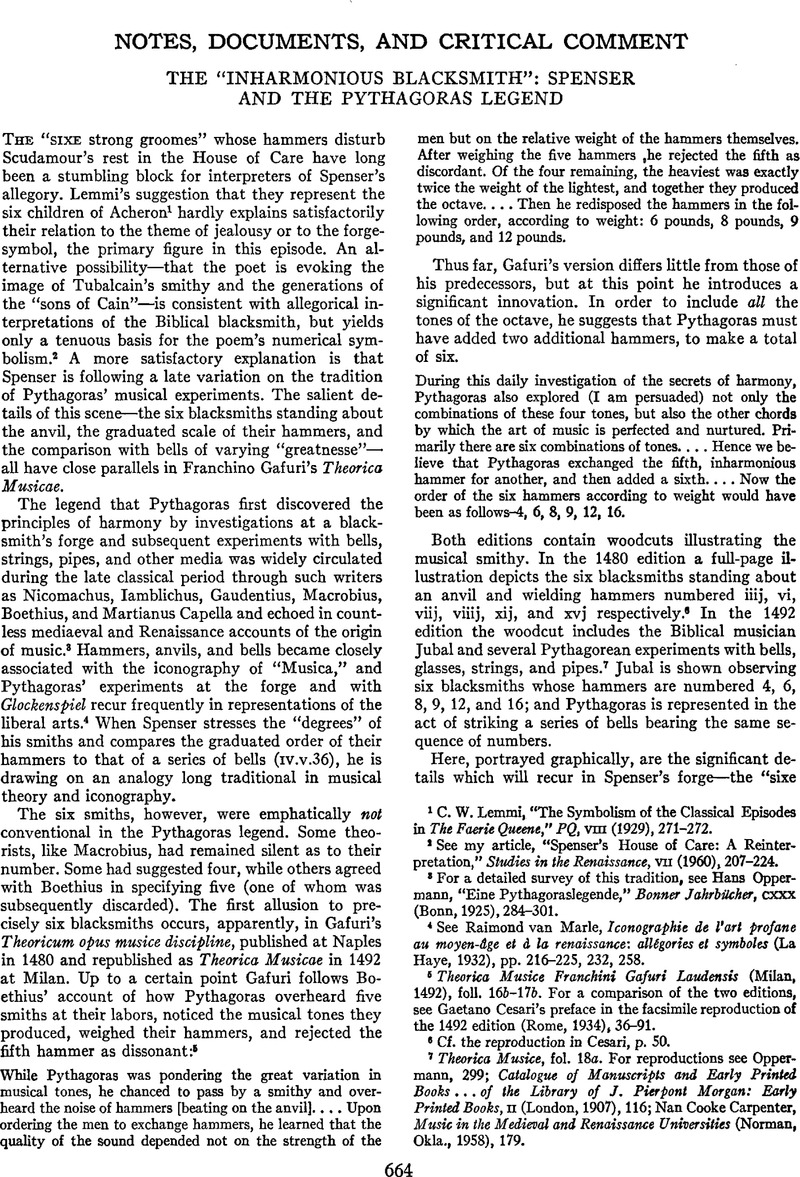No CrossRef data available.
Article contents
The “Inharmonious Blacksmith”: Spenser and The Pythagoras Legend
Published online by Cambridge University Press: 02 December 2020
Abstract

Information
- Type
- Notes, Documents, and Critical Comment
- Information
- Copyright
- Copyright © Modern Language Association of America, 1907
References
1 C. W. Lemmi, “The Symbolism of the Classical Episodes in The Faerie Queme,” PQ, viii (1929), 271–272.
2 See my article, “Spenser's House of Care: A Reinterpretation,” Studies in the Renaissance, vii (1960), 207–224.
3 For a detailed survey of this tradition, see Hans Oppermann, “Eine Pythagoraslegende,” Bonner Jahrbücher, cxxx (Bonn, 1925), 284–301.
4 See Raimond van Marie, Iconographie de l'art profane au moyen-âge et à la renaissance: allégories et symboles (La Haye, 1932), pp. 216–225, 232, 258.
5 Theorica Musice Franchini Gafuri Laudensis (Milan, 1492), foll. 16b-17b. For a comparison of the two editions, see Gaetano Cesari's preface in the facsimile reproduction of the 1492 edition (Rome, 1934), 36–91.
6 Cf. the reproduction in Cesari, p. 50.
7 Theorica Musice, fol. 18a. For reproductions see Oppermann, 299; Catalogue of Manuscripts and Early Printed Books ... of the Library of J. Pierpont Morgan: Early Printed Books, ii (London, 1907), 116; Nan Cooke Carpenter, Music in the Medieval and Renaissance Universities (Norman, Okla., 1958), 179.
8 One of the most detailed accounts of Jubal's discovery occurs in Pedro Cerone's El Melopeo (Napoles, 1613), pp. 228–229. Though this work was published too late to influence Spenser, it provides a valuable example of how completely the Pythagoras legend could be retailored to fit Jubal and his blacksmith brother. It exemplifies, in a more extreme degree, the same type of development we have encountered in Spenser and Gafuri. “The manner in which Jubal discovered the proportions [of musical harmony],” Cerone maintains, “was as follows. One day, upon entering the forge of his brother Tubalcain, the inventor of the blacksmith's art, Jubal heard the hammers produce a [harmonious] concord, because one was heavy, another light, and [the others] of medium weight. Being naturally inclined to music and delighting in the sound of the hammers, which gave such sonorous strokes, Jubal discarded the fifth hammer and weighed the four remaining, in order to learn what proportions produced this concord,” etc.
9 Interpretatio Nomin. Hebr. Chald. Graec. & Lat. (Paris, 1532), fol. 36.
10 Ovid's Metamorphosis. Englished, Mythologiz'd and Represented in Figures (Oxford, 1632), 157.
11 G. C. Macaulay (ed.), The Complete Works of John Gower. The English Works, ii (Oxford, 1901), 419–422.
12 See Calvin Huckaby, “The Structure of Book iv of the Faerie Queene,” Studia Neophilologica, xxvii (1955), 53–64.
13 Cf. John Hollander, The Untuning of the Sky (Princeton, 1961), passim.
14 Spenser's poetic exploitation of the Pythagoras legend should not obscure the probability that, like most of his contemporaries, he accepted it as fact rather than fiction. The tradition of the musical smithy went virtually unchallenged until Dr. Charles Burney delivered the deathblow in 1789. See Charles Burney, A General History of Music, ed. Frank Mercer, i (London, 1935), 342–347.

